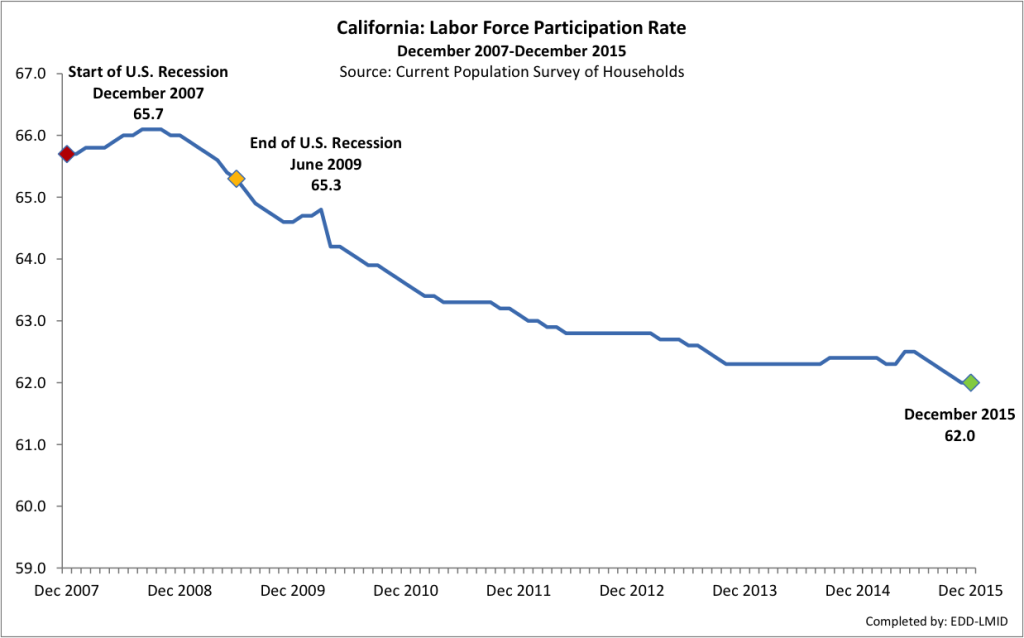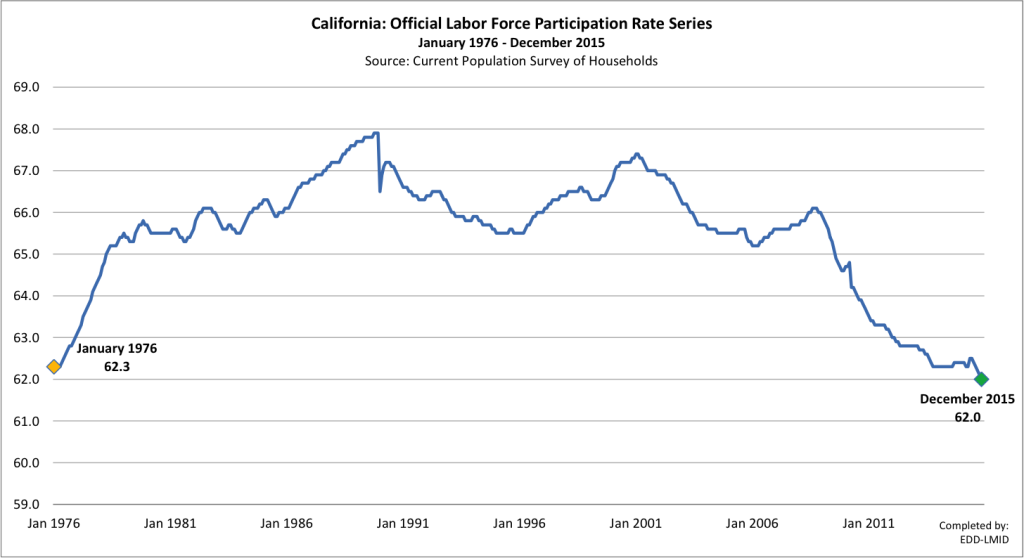 The most recent data on California’s labor force participation rate (the percentage of California adults employed or looking for work) show the rate continuing to decline the past few years, even as job growth is very strong. Why is this? Should workforce practitioners and policymakers in California be concerned? How much does the rate represent increased discouragement among our workforce?
The most recent data on California’s labor force participation rate (the percentage of California adults employed or looking for work) show the rate continuing to decline the past few years, even as job growth is very strong. Why is this? Should workforce practitioners and policymakers in California be concerned? How much does the rate represent increased discouragement among our workforce?
Let’s start with the data, turning to EDD’s Labor Market Information Division. Mr. Brandon Hooker of the Division has compiled the chart above (click to enlarge) that tracks the declining labor force participation rate in California since December 2007. The rate has gone from 66.7% in December 2007 down to 62% in the latest month of December 2015. It would be expected that the labor force participation rate would decrease during the Great Recession. But the slide continued even after the Recession ended.
Mr. Hooker has produced a second chart below (click to enlarge) that shows the labor force participation rate shifts in California since January 1976. The rate grew during the late 1970s and 1980s, reaching a high near 68% before declining during the recession in California in the early 1990s and in the recession of the early 2000s. After each of these recessions, the labor force participation rate rebounded. After the latest recession, it has not grown, but continued a fairly steady decline.
 What are the causes of the decline? California economist Christopher Thornberg, President of Beacon Economics, has been tracking the labor force participation rate in the state and nationally. The national rate, at 62.6% in December 2015 is slightly higher than California’s rate, but it has followed a similar decline since the Great Recession. Thornberg points to three main factors for the decline (8-9 million fewer workers in the labor force than present with the 2005 rate).
What are the causes of the decline? California economist Christopher Thornberg, President of Beacon Economics, has been tracking the labor force participation rate in the state and nationally. The national rate, at 62.6% in December 2015 is slightly higher than California’s rate, but it has followed a similar decline since the Great Recession. Thornberg points to three main factors for the decline (8-9 million fewer workers in the labor force than present with the 2005 rate).
- The large number of “baby boomer” retirements, especially adults over 65 years of age, who have exited the labor force.
- The increased number of adults, 16 years and over, in college, and not in the labor force.
- The increased number of adults on the government disability and other benefit rolls.
Thornberg notes that the labor force participation rate for adults over 65 years of age is actually higher in 2015 at 18.9% than it was in 2005 at 15.1%. However, the population in this group, fueled by baby boomers, was so much larger in 2015 at 46.5 million adults–compared to 35 million adults in 2005–that the overall labor force participation rate was pulled down. In contrast, the labor force participation rate for the prime working age group, 25-44 years of age, was over 81% in 2015.
Added to the aging of the workforce, according to the Thornberg, was the increase in college attendance among adults, roughly 2.5 million more adults in school in 2015 than in 2005, as well as the growth in the disability rolls, which Thornberg estimates at 3 million more.
Utilizing Thornberg’s data, the declining labor force participation rate appears less the product of discouragement than of demographics. The number of adults over 65 is at its highest level, and the next age cohort, 55 to 64 years of age, is also at a high of 40.5 million workers. The increase in college attendance reflects both the youth population and the social forces pushing toward higher college attendance.
Yet, demographics does not offer a full explanation. Anyone who works with job seekers throughout California today knows that workers in their mid-50s and over are retiring in part because of the difficulty more and more are encountering in finding employment. This is true not only in entertainment and technology—two sectors usually cited as unfavorable to older workers—but across all sectors, where employers have considerable choice among workers, even with tighter labor markets.
Further, demographics does not explain Thornberg’s third factor, the increased disability and other benefit rolls. As noted in these pages over the past few years, the disability rolls have skyrocketed in size since the early 2000s, especially Social Security Disability Insurance (SSDI). SSDI was at nearly 8.9 million workers on its rolls in December 2015, up from 6.5 million in 2005. And once on SSDI few exit for work. A Mathematica study found that over a ten year period after going on SSDI, less than 4% of workers exited for work.
Persons on all sides of the political spectrum decry the growth in disability rolls—as reflected in the recent bi-partisan AEI/Brookings “Consensus Plan for Reducing Poverty”. So far, though, all previous workforce initiatives have proved ineffective.
As Thornberg helps us understand, the declining labor force participation rate in California is more nuanced than the characterization sometimes presented—the rate as reflecting discouragement with a stagnant economy. But discouragement is a factor, and demographics alone cannot fully explain the decline.

